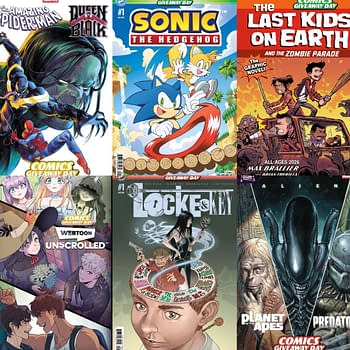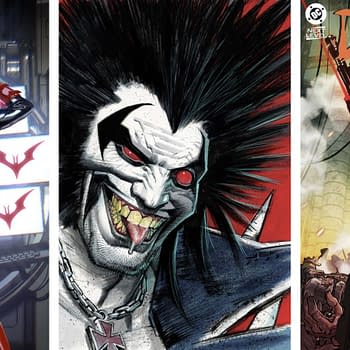Posted in: Comics, NYCC | Tagged: Babs Tarr, Comics, james tynion iv, jenny woods, Kevin Wada, kris anka, LGBTQ, NYCC, NYCC 2015, steve orlando
NYCC'15 – NY TimesOUT LGBT in Comics
By Joe Glass

Asking Steve about Midnighter, one of the only monthly books from DC about an unapologetic, openly gay man – how will him being single now progress and develop the character? Orlando feels it was important to show Midnighter as himself, rather than being defined by his relationship – be Midnighter, not Midnighter AND APOLLO.
It was important to have him with no secret identity, him being himself 100% of the time. He also talked about the change in times, how this isn't 1998 anymore, now we have Modern Family, though admits it was needed to show a gay man in a frank and honest way, rather than a soft, suggestive way.
He talks about while sure, Midnighter is violent and maybe not a good role model in that way, his way of living his life is, that 100% open honesty. But he does feel we all wanted 'that type of hero' who'd stand up for us when we're being bullied and abused. And he points out that is relatable not just to queer kids, but everyone has felt that way at times.
Moving onto Tarr, we talk about the controversy of Batgirl 37, and how the team apologised for some negative language and poor tropes used in the issue, and changed it for the trade. Tarr says the team felt it was important to make the change and make the apology and the response has been positive.
Wood talked about how in her book, Flutter, which features a girl who can change into a guy, it was important to show the difference in reactions to each gender, and how each gender has its own benefits and problems.
When asked about how to approach covers for the artists, Wada immediately states how fashion is important. Tarr discusses how she loves how she gets to own it from start to finish, being able to color their own work etc. Anka points out how he's made a fair few covers for Marvel that are solid pink, which is a color he loves and it stands out because few people use that color palette in comics.
Moving onto costume redesigns, and how they approach, Anka says he likes to try and hold onto something from previous costumes, he's a research fiend for it, including even their casual clothes, and he mentions working out what Carol Danvers would wear to the gym for Captain Marvel 1 – but it mainly starts with working out who the character is. Tarr feels the same, and with Batgirl her being 21 it involved trying to make something a bit more relatable. Tarr says it's okay to be sexy, but not to sexualise a costume.
Tarr mentioned how she has boards with different casual styles for Babs, including more librarian styles as she starts to mature, over the comfy student styles she wears now. She does say its a lot of work keeping up ith fashion styles, but websites like ASOS are a help. Wada points out he only did one design, and his process to go full-out FASHION, and then dial it down and add more superhero elements, and talks about the collaborative process. He jokes if you hate it, it's the editor, if you love, it's them.
Tynion is asked about how Memetic has no straight white male leads, and he says that is deliberate, he wanted to show the diversity and be there for more people. He talks about the book and its story, and how the characters in it all serve very specific sides, including characters dealing with the human side of the attack, and others the government stuff. He just felt they didn't NEED to be straight white guys, so why would he make them that. He wants all his books to be representative of the world around him.
Asked then about balancing creator owned work and his big mainstream books, he says each one stretches a different muscle, he couldn't do multiple books which were all the same kind of thing. He mentions how Batman & Robin Eternal will get dark in places, but Batman/TMNT is pure fun. Each book allows him to express a different part of himself. The Woods is young adult in a way, but Memetic was high concept sci-fi horror. He says if he was writing four books that were fundamentally identical he'd go insane.
How much of themselves do they find putting into the work? Tarr straight off the bat says a lot, she's lucky that she has writers that write things that get her excited and how she can make suggestions of things she'd love to draw and the writers will work that in for her. Wood brings out how Flutter is a very personal story for her, and how growing up in a small town she wondered what it would be like to be a guy taking a girl to the movies, as she feels she couldn't where she's from.
Orlando says how sure, there's a lot of things in his books which he doesn't personally do, like cut someones head off, though he jokes about try talking to him on Sunday, but he says that's what you have to do, because you can't have always done the things you're writing about. But you can look at how it reflects things in your life, and mentions how it comes up actually in Midnighter 6 next month. That's showing respect for the readership and the character, by not giving them a storybook romance, but a real one that people can relate to.
Tynion feels each character in The Woods represents an aspect of him. He wanted to deal with him struggling with control, over his own life and others and how that can be an important moment of growing up, but it's also allowed him to deal with queer and weight issues too. He feels it is his most personal work.
On whether aspects of their previous works (fashion, animation, manga, tv games) have ever been moved over into comics, and Tarr says there are things she misses (particularly the organisation she jokes), but also there are stresses she doesn't. Anka feels with animation he learned how to always make his deadlines, and working to manage his time better (he points out in five years he hasn't missed a deadline, though joked he just has). Tarr did point out that missed deadines however are not always the fault of the artist. Wada says he found the fashion was unexpected to him because he didn't come from a fashion background as everyone assumes, but rather an editorial imagery background.

The key is to make sure you know those characters beyond their sexuality, you know their interests and passions. Wood agrees you shouldn't make the characters sexual orientation the most fascinating thing about them. Tynion says there's even an historical element to that, how maybe 20 years ago coming out was a similar experience to most people, but in his lifetime that has changed. Maybe at some point there was this more archetypal character, but that person doesn't exist anymore.
What are you reading yourself and would recommend for someone looking for LGBT things? Wood says Duck by Tana Ford, a lesbian series about a real community of women. Saga and Southern Bastards were Tarr's picks. Wada is all about Saga and The Wicked + The Divine. Tynion says the main Star Wars book, and Raina Tenkelmire (I'm unsure if I have that name right, I apologise). Orlando says when it comes to queer in comics he feels he had to do an inventory of his brain, but he mentions Love Letters, and Enormous. Anka is much more of a TV guy, so he mentions Black Sails, in particular the character of Captain Flint.
The floor is opened for Q&A, Orlando was asked about Virgil, he talks about JD Faith wanted to tackle the hard boiled action style story, then Orlando came up with working what he wanted to bring to it, and in research he was shocked about the human rights offences in Jamaica against the LGBTQ community, and that drove him to make Virgil about that. He wanted to spread the word with that story, and it was cathartic. This question came from a reader who appreciated coming from a queer in Jamaica background by the way.
Orlando discussed how it is impossible to control a character once you're finished with them, to a question about how you can make the queerness of the character stick and not something to be retconned, except maybe to make that version of the character the iconic version of the character. Tynion says the best thing to do sometimes is to state it outright. When he took over Hellblazer, they wanted to make his bisexuality apparent from the outright.
With the new costume, what fashion inspiration went into Batgirl? Tarr states how it was a collaboration between her and Cameron Stewart, and how it was mostly done when she came to it but she made additions, added to it, added fashion she loves. She tried to make it feel like something she could have picked up at a thrift store.
Joe Glass is a Bleeding Cool reporter and comics writer, writing LGBTQ comic series The Pride and co-writing Welsh horror comedy series, Stiffs.
















